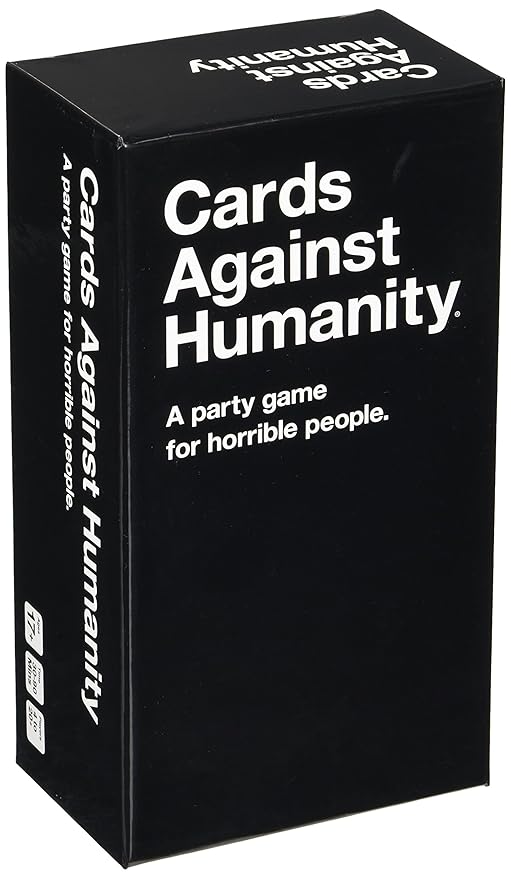Gobble Gobble!
This Thanksgiving is definitely one for the books, and it’s safe to
say to was a treat! (See what I did there? Some of you may think my
joke is more for October due to the token phrase “trick or treat” but I
feel its fitting!) I had a moment that made
me think of some of the readings we had for last week, which was using
popular culture as a way of learning.
My family tradition for the holidays is to play card games and
watch the football game, this year the game we played was Cards Against
Humanity, and if you haven’t played it just know it’s a card game for
horrible people. Another good example, is Apples
to Apples, but with a twist.
Each player gets 10 white cards with responses and there is a stack
of black cards with fill-in-the-blank phrases in the middle of the
group, with each round a black card is read aloud by a player (going
counter clockwise) and the remaining players would
place down a white card with their responses, the player who read the
black card will choose the best phrase (all in their opinion) and the
player who won that round gets the black card. The game will continue
until a player gets 5 black cards and wins the
game.
Anyway, we were playing the game some cards came up and not
everyone knew what it was and me being me I wanted to help, to be a
guide if you will and together we all learned. I gave examples to help
with some of the terms and phrases that seemed to make
the game even more interesting!
Disclaimer: I am going to give an example of what was said to
further explain my experience, the next section will include some sexual
commentary and a rather lengthy response. Enjoy?
Where was I? Oh yes, Cards Against Humanity.
Now the phrase came up on the black card “What did the white men
bring to the New World?” (how fitting for the holiday, but I digress) The responses were… horrible to say the least.
One response was “Necrophilia” and almost everyone was confused on what
this word actually meant. I gave the example
of a movie that we all watched together called “Contracted” on Netflix,
and if you have a strong stomach give it a look but not at the expense
of throwing up all that good holiday food. #LeftOvers
So in the movie the opening scene shows a man having sex with a
corpse in a morgue and that is how I taught them the meaning, and
unfortunately they were disgusted and a few cousins left the table after
watching the trailer, but the most important thing
is that we all learned together! Given this is a LOOSE example of
learning with popular culture, it can still be academic even in
something a simple as a card game. The game stopped but the learning
continued because from then until today my family has been
talking about that moment. Although that moment was small, it made an
impact and it is obviously something they will not be forgetting anytime
soon. Who said learning can’t be fun? Or a little disgusting?
#ShanWOW #lightningBolt #ShakenNotStirred

Sex with A CORPSE?!!! The drama surrounding that scene is enough to engage and capture attention which is so important in teaching. I think that is what needs to be done sometimes, students need to be #shook as I like to say when using examples. I feel like my students are caught up in the monotony of using The Office examples, and would really benefit from something that caught them off guard to keep them excited and engaged in the material.
ReplyDeleteHey Shannon! Using popular culture in the classroom has always been a method I integrate within my pedagogy. When using popular culture references I have the ability to relate the course content and course material to students more clearly, establishing more credibility with my students. When using examples such as The Office or music videos such as "This is America" or "Love the Way You Lie," can help describe how we rhetoric is used in our daily lives. If I were to simply use a powerpoint slide to discuss how we use rhetoric in our everyday lives, the students may not retain or understand the information as clearly as when I use popular culture as a reference. Using popular culture within the classroom can help establish credibility with students, Dannels (2014) stated that when students perceive the teacher as more relatable, they are more likely to perceive the teacher as more credible. Therefore, using popular culture can help explain material more clearly to students while also helping the teacher establish credibility with the students.
ReplyDeleteI like how you used your family card game to initiate a learning moment- even if it was a little nasty!! I definitely agree with Kimberly when she said that catching the students off guard with a clip (maybe not having sex with a corpse) but something that provokes them in a different way than some type of traditional pop culture like a T.V. show that everyone has seen before. I definitely think that integrating pop culture in your teaching is vital to having a class engaged in discussion!
ReplyDelete